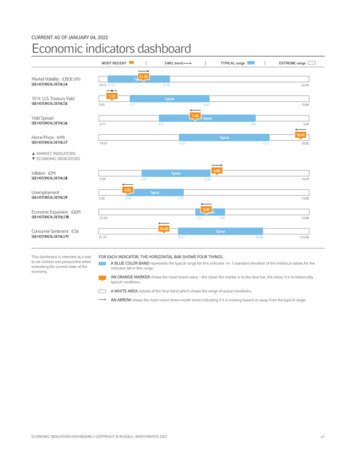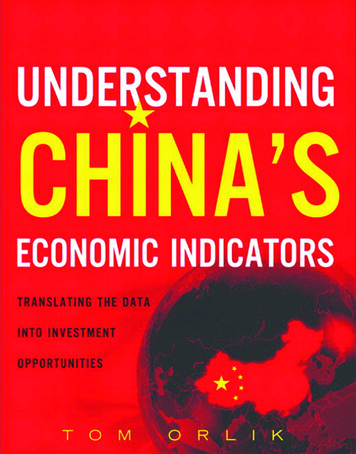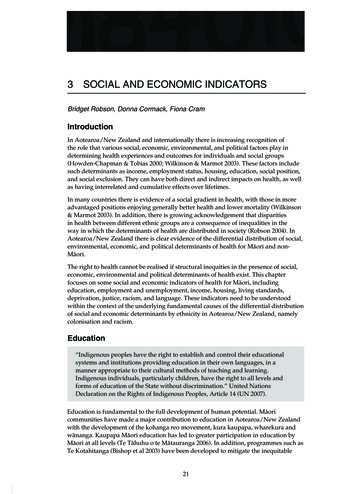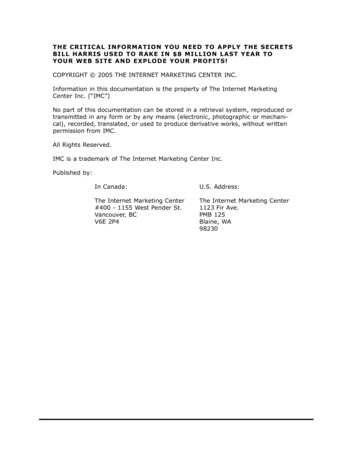
Transcription
10 Economic Indicators You Need to KnowA quick cheat sheet for investors and tradersHALIFAX AMERICA 2016
Risk Disclosure: This document has been published strictly for education purposes. It does not claim to cover everyaspect of the economic indicators presented. Its goal is to provide basic information that may help investors and traders quickly get a grasp atunderstanding how these indicators work and what they aim to measure. It’s like “cheat sheet.”If you have any questions about any material in this document, feel free to contact Halifax America atinfo@halifaxamerica.com or by phone at 1-888-240-7099.Trading Futures, Options on Futures, and Forex involves substantial risk of loss and is not suitable for all investors. Carefully considerwhether trading is suitable for you in light of your circumstances, knowledge, and financial resources.You may lose all or more of your initial investment and only risk capital should be used. Opinions, market data, and recommendationsare subject to change at any time. The lower the margin used the higher the leverage and therefore increases your risk. Pastperformance is not necessarily indicative of future results.
1 - Consumer Price Index (CPI)What is it?Published monthly by the Bureau of Labor Statistics (BLS), the Consumer Price Index (CPI) shows changesin the prices paid by urban consumers for a representative basket of goods and services.Why is it important?Monthly changes in the CPI represent the rate of inflation.What other details should I know?The BLS publishes the All Items CPI for All Urban Consumers which is known as the headline CPI. The AllItems CPI Less Food and Energy is known as the core CPI and is less volatile than the headline CPI.Social security and federal retirement benefits are updated each year for inflation by the All Items CPI forUrban Wage Earners and Clerical Workers (CPI-W). The headline CPI is used to adjust individual income taxparameters to prevent bracket creep.
2 – Durable Goods OrdersWhat is it?Let’s start with the term “durable goods.” It refers to goods that have a lifespan of three years or more. Forexample, refrigerators, cars, mobile phones, and bricks are goods that fall under the durable goods category.The Durable Goods Orders report, released monthly, presents data compiled from a survey of manufacturers’shipments, inventories, and orders. The report features new orders placed with domestic manufacturers forthe immediate and future delivery of factory hard goods. It’s also important to note that the survey is sent tomost manufacturing companies with 500 million or more in annual shipments.Why is it important?Durable goods orders are a leading indicator of industrial production and capital spending.Durable goods orders show how busy factories will be in the months to come. An increase in demand fordurable goods can lead to an increase in industrial production and capital spending, indicating a growingeconomy. A decline in demand for durable goods can lead to a decrease in industrial production and capitalspending, which may indicate a contracting economy.
3 – Employment ReportWhat is it?The Employment Report is a report on the state of the labor market, its two main components being 1) thenumber of new jobs created (nonfarm payrolls) and 2) the unemployment rate.The Employment Report measures the state of the labor market based on the following premises: People with jobs are employed.People who are jobless, looking for a job, and available for work are unemployed.Those who do not fall in one of these categories—freelancers, for example--are not considered as partof the labor force.This report is released monthly on the first Friday of the month by the Bureau of Labor Statistics (BLS) of theUnited States Department of Labor.Why is it important?The Employment Report provides one indication as to whether the economy is expanding orreceding.A lower unemployment rate and increasing nonfarm payrolls are indicators of an expanding economy. Ahigher unemployment rate and decreasing nonfarm payrolls are indicators of a contracting economy and apossible recession.What other details should I know?What are nonfarm payrolls?Each month the BLS surveys 146,000 businesses and government agencies to provide detailed data onemployment, hours, and earnings. The most significant of these three is the employment number. This is thenumber of employed people.What is the unemployment rate?Each month the BLS surveys 60,000 households representing approximately 110,000 individuals to determinewhat percentage of these individuals are employed. The BLS determines the unemployment rate based on theresponses to the survey questions.
4 - FOMC Meeting AnnouncementsWhat details should I know?Understand monetary policy basicsThe Federal Reserve (commonly referred to as the Fed) is the nation’s central bank. Monetary policy is whatthe Fed does to influence the amount of money (money supply) and credit in the U.S. economy. The goals ofmonetary policy are to promote maximum employment, stable prices, and moderate long-term interest rates.What is the role of the FOMC?The Federal Open Market Committee—also known as the FOMC--meets eight times a year and decidesmonetary policy. It votes on the discount rate, the fed funds rate target, and the monetary policies toimplement these decisions. When the Fed announces theses policy decisions it is called the FOMC meetingannouncement. This announcement is the single most influential event for the markets.How what tools does the FOMC use to influence monetary policy?The Fed’s three tools of monetary policy are open market operations, the discount rate, and reserverequirements. Open market operations are the primary tool of the Fed and consists of the Fed making purchasesand sales of government securities such as treasury bills, notes, and bonds in the open market. Whenthe Fed buys securities it increases the money supply which can lower interest rates and when it sellssecurities it reduces the money supply which can raise interest rates.The discount rate is the rate the Fed charges banks on short-term loans. The fed funds rate is therate when banks borrow from one another instead of borrowing from the Fed and the rate mirrors thediscount rate closely.Reserve requirements are the percentage of deposits that banks must maintain in their vaults or at aFederal Reserve Bank. Lower reserve requirements mean banks can lend more. Higher reserverequirements mean banks can lend less.Why is it important?Interest rates significantly affect the overall economy.Lower interest rates tend to stimulate economic activity and higher interest rates tend to slow economicactivity. Monetary policy effects the interest rates paid to borrow money; for businesses, mortgage loans,credit cards, and car loans, to name a few.
5 - Gross Domestic Product (GDP)What is it?The United States Gross Domestic Product represents the total dollar value of all goods and servicesproduced over a specific time period; you can think of it as the size of the economy.Released quarterly, GDP is calculated by adding total consumption, investment, government spending and netexports. Note that this report is subject to monthly revisions by the Bureau of Economic Analysis (BEA) of theDepartment of Commerce.Why is it important?GDP illustrates an economy’s rate of (positive or negative) growth in percentage terms.Usually, GDP is expressed as a comparison to the previous quarter or year. For example, if the year-to-yearGDP is up 3%, this is thought to mean that the economy has grown by 3% over the last year.A recession is negative economic growth for two consecutive quarters. A growing economy usually meansmore hiring and more business profits while a slowing economy usually means les hiring or layoffs and adecline in business profits.
6 - Housing StartsWhat is it?The New Residential Construction Report, also known as Housing Starts, presents the number of newresidential construction projects that have started in a given month. The report is compiled from surveys ofhomebuilders across the nation.Released on around the 17th of each month by the U.S. Commerce Department, the Housing Starts reportincludes housing completion, new housing construction projects, and building permits.Why is it important?An upsurge in residential housing development is leading and key indicator of economic strength.The housing industry accounts for about 17% of the overall economy (see GDP). More new home buildingmeans more demand for labor to build the homes, building materials, and durable goods including washers,dryers, and refrigerators.Sustained increases in housing starts trigger economic growth and mean the economy is growing. Sustaineddecreases in housing starts could trigger an economic slowdown and a recession.
7 - ISM Manufacturing IndexWhat is it?The ISM Manufacturing Index provides a snapshot of the ebb and flow of business conditions--employment,production, inventories, new orders and supplier deliveries. Published by the Institute of Supply Management,this index is a compilation of survey data from over 300 manufacturing firms.Why is it important?Manufacturers are among the first to respond to the changes in demand.This puts them in a unique position to observe the ebb and flow of supply/demand conditions that drive theeconomy. One of the first reports to be released in the month, the ISM Manufacturing Index is a leadingindicator that may influence investor and business confidence, setting the tone to which market participantsrespond.The trend of the direction of the readings is what is more significant than individual readings. The range of thereadings are 0 to 100. 50 is the magic number. A reading of 50 or higher indicates that the economy isexpanding and readings below 50 indicate an economic contraction and 50 indicates no change.
8 - Personal Income and Outlays ReportWhat is it?The Personal Income and Personal Consumption Expenditures (Outlays) Report, produced by the Bureau ofEconomic Analysis, presents two sets of data that track personal income and monthly spending.Personal income is the dollar value of all income received by individuals in the U.S. Personal spending is thedollar value of purchases made by individuals in the U.S. of both durable and non-durable goods.Why is it important?This report helps gauge the strength of the consumer sector in the U.S.—which comprises two thirds of theU.S. Gross Domestic ProductThe data presented in this report indirectly influences capital spending, investment, and imports. Increasingconsumer spending is an indicator of a growing economy and decreasing consumer spending is an indicator ofa contracting economy.This report also helps investors track where money is being spent, whether monies are flowing into durable ornon-durable goods and services, indicating which companies might present more suitable investmentopportunities.
9 - Producer Price Index (PPI)What is it?The Producer Price Index measures the average change in selling prices from the domestic seller’sperspective, standing in contrast to the CPI, which measures price change from the consumer’sperspective.The price changes are measured from month-to-month, sampling over 25,000 establishments thatprovide approximately 100,000 price quotations. PPI also covers a wide range of industries includingmining, manufacturing, services, agriculture, utilities, and construction.Why is it important?The PPI indicates whether producer prices are declining or rising, and whether price changes are beingpassed from businesses to consumers.When businesses pay higher or lower prices to producers, businesses can either pass along all or part of theseprice changes to consumers. How businesses deal with price changes stemming from production costs willinvariably affect their profitability.
10 - Retail SalesWhat is it?The Retail Sales report is an economic indicator that measures the sales of retail goods over on a monthlybasis. Compiled and released by the Census Bureau and the Department of Commerce, this report measuresconsumer demand for finished goods.Retail Sales also takes into account sales from in-store and out-of-store sales (such as catalog sales) andbreaks down sales figures into various groups such as food and beverages, clothing, automobiles, etc.The report is also presented with and without automobile sales, as auto sales and prices can add volatility tothe data. The data for this report is compiled through surveys sent out to 4,900 employer units--companies, orparts and divisions of companies.Why is it important?A leading macroeconomic indicator, retail sales help gauge whether an economy is expanding or contracting.Consumer spending accounts for two-thirds of the United States economy. Retail sales account for one-half ofconsumer spending and a third of economic activity (see GDP). Higher retail sales can indicate an expandingeconomy. Lower retail sales can indicate a contracting economy.
Jun 10, 2017 · aspect of the economic indicators presented. Its goal is to provide basic information that may help investors and traders quickly get a grasp at understandin











